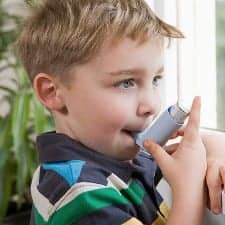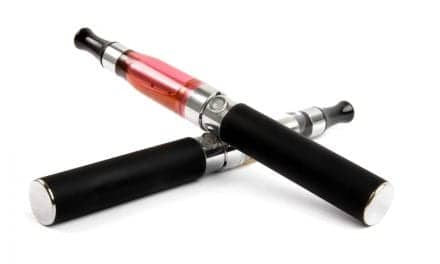The American College of Allergy, Asthma and Immunology (ACAAI) is sponsoring the 13th annual Nationwide Asthma Screening Program this spring.
The screening program is ACAAI’s public service campaign to help adults and children find out if their breathing problems might be symptoms of asthma. The program also gives diagnosed asthmatics a chance to find out if their disease is under control.

ACAAI-member allergists across the country volunteer to offer free asthma screenings in their communities at shopping malls, schools, health fairs, and other public locations. The program has screened more than 115,000 people in the past 12 years, referring half for further diagnosis.
The registration deadline is March 15. However, College members who are registered have until April 30 to submit the date and location of their asthma screening. Screenings may be offered at any time.
As screenings are scheduled, they will be posted on the College’s Web site at www.acaai.org under the Patient Education section. Most screenings will take place in May.
For further information, call (312) 558-1175.
Researchers Utilize PDAs to Monitor TB Patients in Peru
MIT graduate student Joaquin Blaya developed a method for tracking test results required from drug-resistant tuberculosis patients through personal digital assistants (PDAs). Blaya’s idea stemmed from the time-consuming job of tracking the numerous test results required over the 2-year treatment period for patients with drug-resistant TB, particularly in developing countries where health workers rely on paper copies.
The project launched in Lima, Peru, where the researchers found that equipping health care workers with PDAs to record data, dropped the average time for patients’ test results to reach their doctors from 23 days to 8 days.
“You can monitor patients in a more timely way. It also prevents results from getting lost,” says Blaya, a PhD student in the Harvard-MIT Division of Health Sciences and Technology (HST).
Working with faculty members from HST and Brigham and Women’s Hospital, Boston, Blaya launched the PDA project in Lima. He also worked closely with the Peruvian sister organization of Partners in Health, Socios en Salud. “The way to solve health care problems is by involving the community,” Blaya says.
The old patient tracking system required a team of four health care workers to visit more than 100 health care centers and labs twice a week to record patient test results on paper. The workers would then return to their main office to transcribe those results onto two sets of forms per patient—one for the doctors and one for the health care administrators. This process took an average of more than 3 weeks per patient with the added potential for error due to information copied by hand multiple times.
With the new system, health care workers enter all of the lab data into their handheld devices, using medical software designed for this purpose. When the workers return to their office, they sync the PDAs with their computers.
Peruvian health care workers enthusiastically embraced the program, which started in two of Lima’s districts and has now been expanded to all five. In addition to saving time, the handheld devices are more cost-effective than the paper-based system, the researchers reported in the International Journal of Tuberculosis and Lung Disease.
Indoor Air Pollution Increases Asthma Symptoms
A study by researchers at the Johns Hopkins University found an association between increasing levels of indoor particulate matter pollution and the severity of asthma symptoms among children. The study is among the first to examine the effects of indoor particulate matter pollution. The results are published in the February 2009 edition of the journal Environmental Health Perspectives.
Researchers from the Center for Childhood Asthma in the Urban Environment followed 150 asthmatic children, ages 2 to 6, for 6 months. Environmental monitoring equipment measured the air in the children’s bedrooms for more than three 3-day intervals. Air measurements were taken at the beginning of the study, after 3 months, and again after 6 months; 91% of the children who participated in the study were African-American, were from lower socioeconomic backgrounds, and spent most of their time indoors.
The investigators found that substantial increases in asthma symptoms were associated with higher indoor concentrations of both fine particles and coarse particles, according to Meredith C. McCormack, MD, MHS, lead author of the study and an instructor with the Johns Hopkins School of Medicine.
For every 10 micrograms per cubic meter of air (mg/m3) increase in indoor coarse particle concentration, there was a 6% increase in the number of days of cough, wheeze, or chest tightness, after adjusting for a number of factors. For every 10 mg/m3 increase in fine particles measured indoors, there was a 7% increase in days of wheezing severe enough to limit speech, and after adjusting for various factors, a 4% increase in days on which rescue medication was needed. In many cases, the level of indoor fine particle pollution measured was twice as high as the accepted standard for outdoor pollution established by the Environmental Protection Agency.
Study authors concluded that improving indoor air quality and lowering indoor PM concentrations may provide additional means of improving asthma health, especially for children living in inner cities.
Smoking Kills—Irrespective of Social Class and Gender
A well-off professional who smokes has a much lower survival rate than a nonsmoking low-paid worker of the same sex, concludes new research published on bmj.com.
The study, one of the first to examine the long-term impact of smoking on older men and women, shows that smoking itself is a greater source of health inequalities than social position. Among both men and women, smokers of all social classes had a much higher risk of premature death than nonsmokers from even the lowest social classes. Surprisingly, non-smoking women in the lowest social classes had one of the lowest death rates.
The research also found that the survival advantage that women normally have over men is cancelled out by smoking. As the authors say, “In essence, neither affluence nor being female offers a defence against the toxicity of tobacco.”
Dr Laurence Gruer and Dr David Gordon from NHS Health Scotland and Professor Graham Watt and Dr Carole Hart from the University of Glasgow studied the impact of smoking on the survival rates of 15,000 men and women recruited in 1972-1976. The participants were grouped by gender and social class and further divided into smokers, never-smokers, and ex-smokers. The social class category was sub-divided as I and II (highest); III non-manual; III manual; and IV and V (lowest).
Death rates for the participants were assessed after 14 years and 28 years. The results show that smokers had much higher death rates than never-smokers among both women and men and in every social class. After 28 years of follow-up, 56% of female never-smokers and 36% of male never-smokers in the lowest social classes (IV and V) were still alive compared with only 41% of female smokers and 24% of male smokers in the top two social class groups (I and II). Smokers in the lowest social classes fared even worse.
On a positive note, the study found that the death rates of ex-smokers were much closer to those of never-smokers than smokers, showing that quitting does make a difference regardless of social position.
Dr Gruer, Director of Public Health Science at NHS Health Scotland, said, “This study reinforces current policies in the United Kingdom and other countries aimed at helping smokers stop smoking. Accessible and effective smoking cessation advice and services, as well as strong action to discourage young people from starting to smoke, are key to reducing health inequalities. With over 23% of adults in the UK still smoking, rising to well over 40% in some places and groups, it’s crucial we continue to make smoking cessation a top priority.”
Stringent, Controversial Smoking Bans Effective in Boston
Strict antismoking regulations went into effect on February 9 in Boston after being passed by health authorities in December, giving Boston some of the most strict tobacco-control regulations in the United States. Cigarette sales are now banned in Boston pharmacies, including those in grocery stores, as well as college campus convenience stores.
The Boston Globe examined implementation of the new rules, noting, “A random sampling of pharmacies in Boston’s South End and Back Bay neighborhoods showed that the stores had all removed tobacco products as required.”
Ann Scales, spokeswoman for the Boston Public Health Commission, told the Boston Globe, “Much to everybody’s surprise, those products were gone. In fact, they were saying a lot of the stores had made the changes [before the ban officially went into effect]. It just seems so seamless.”
Smoking was already prohibited on the patios of restaurants and bars with outdoor service. However, Boston’s Public Health Commission added to the regulation that there can be no smoking in hotels, inns, or bed and breakfasts, or outdoors adjacent to indoor work areas.
The new regulation eliminated the sale of blunt-wrappers (tobacco-based rolling papers) anywhere in the city. Blunt-wrap makers have sued the city for unconstitutionally being singled out for elimination while cigarettes can still be sold at neighborhood markets and other outlets.
Another provision sparking controversy is the new ban on smoking bars, such as hookah and cigar bars. The provision states that current smoking bar owners must be out of business in 10 years.
Congress Increases Tobacco Taxes to Fund SCHIP Program
The US Congress and President Obama passed legislation to increase federal tobacco taxes, including a 62-cent increase in the cigarette tax and an immediate increase in the tax on so-called “little cigars” to $1.01 per pack. Congress also expanded the State Children’s Health Insurance Program (SCHIP), which will be funded in part by the newly increased tobacco tax.
Increasing tobacco taxes is a proven strategy to reduce smoking and other tobacco use, according to the Campaign for Tobacco-Free Kids, with studies showing that every 10% increase in the price of cigarettes reduces youth smoking by 7%. Polling conducted for the Campaign for Tobacco-Free Kids found that more than 66% of all voters support a significant increase in the federal cigarette tax to provide health care coverage to uninsured children.
According to Matthew L. Myers, president of the Campaign for Tobacco-Free Kids, the cigarette tax increase is expected to keep 2 million fewer kids from starting to smoke, help more than 1 million adult smokers quit, and prevent nearly 900,000 smoking-caused deaths. Additionally, the tax increase will produce $44.5 billion in long-term health care savings by reducing tobacco-caused health care costs.
Lung Transplantation Survival Rate Correlates to Number of Procedures Performed
Hospitals that perform at least 20 lung transplants a year, on average, have the best overall patient survival rates and lowest number of deaths from the surgery, according to a new Johns Hopkins study.
“Lung transplantation is an incredibly complex procedure, and our results show that the so-called ‘center-effect’ is a very real phenomenon: Hospitals that do more, do them better,” says senior investigator and transplant surgeon Ashish Shah, MD. “For best patient outcomes, you need the right staff operating at peak skill level, with patient support systems ingrained in both their clinical operations and their organization’s culture.”
For those institutions performing 20 or more lung transplants annually, the researchers found that the chances of an organ recipient surviving the critical first month of recovery are more than 95%. Chances of recipients surviving the first year after surgery are 83%.
A sharp contrast is found for the three quarters of hospitals performing significantly fewer lung transplants. Survival rates through the first month drop to 90% if the hospital performs two or fewer lungs transplants per year, and to 73% after 1 year. This, researchers say, occurred despite lower-volume centers having fewer severely ill patients than higher-volume centers.
The study is believed to be the first overall assessment of how each of the 79 US and Canadian medical centers licensed to perform lung transplantation measures up since the procedure was perfected and widely adopted in the 1990s. Roughly 20 institutions perform 20 or more lung transplants annually, on average.
“Our hope is that this evidence will be useful in establishing budgets and staffing objectives so that low-volume centers, too, can steadily improve their patient outcomes in lung transplantations,” Shah says.
For this study, researchers reviewed 10,494 patient records for all single-lung and double-lung transplants performed in the United States and Canada from 1998 to 2007. The data came from the United Network for Organ Sharing, a national network that allocates donated organs across the country.
“Our findings do not mean that only high-volume centers should perform lung transplantation,” says lead investigator Eric Weiss, MD, a postdoctoral research fellow in cardiac surgery at Hopkins.
The research was presented January 27 at the 45th annual meeting of the Society of Thoracic Surgeons in San Francisco.
Asthma Drugs Need to be Maintained for Continued Benefit
Children whose asthma improved while taking steroid drugs for several years did not see those improvements continue after stopping the drugs, new results from a comprehensive childhood asthma study show.
The results come from the Childhood Asthma Management Program (CAMP) clinical trial, in which more than 1,000 children age 5-12 were treated for mild to moderate asthma over more than 4 years at eight centers, including Washington University School of Medicine in St Louis. The children in the randomized trial were divided into three groups: one received twice-daily budesonide, an inhaled corticosteroid medication; one received nedocromil, an inhaled nonsteroid medication; and one group received a placebo. All children received albuterol, a bronchodilator, and oral corticosteroids as needed for asthma symptoms.
This study, published in advance online publication of the Journal of Pediatrics, followed up with the children nearly 5 years after the end of the trial. Researchers found that the children, now in their late teens, who took the medications during the trial showed no difference in their asthma control compared with the children who received the placebo.
“The interesting thing is that as kids with asthma get older, they actually do better,” said Robert C. Strunk, MD, a Washington University pediatrician at St Louis Children’s Hospital and lead author of the study. “We used to say they were outgrowing their asthma. What we know now is that as they go from being young children to age 20, their airways get bigger. They still have asthma but don’t have as much trouble from it.”
Inhaled corticosteroids such as budesonide have been shown to be the most effective form of anti-inflammatory treatment for asthma by controlling symptoms and improving pulmonary function. Results from the original CAMP trial showed that using budesonide twice daily led to fewer hospitalizations and urgent care visits, fewer days in which additional asthma medications were needed, and a reduced need for albuterol, a fast-acting drug for relief of acute asthma symptoms. Using nedocromil twice daily reduced urgent care visits and courses of oral steroids for severe symptoms, but did not affect the number of hospitalizations, symptoms, or airway responsiveness.
Although the patients had fewer symptoms 5 years after stopping the daily medication, Strunk cautions that doesn’t mean that they can stop using asthma medications altogether or that their asthma is cured.
“While the kids did get better with age and didn’t seem to need the medicine as much, laboratory measurements indicated that they were still having symptoms, and therefore were primed to an attack if they got a bad cold or were exposed to a significant weather change,” Strunk said.
The researchers determined that continued benefit of these medications likely requires continued use.
“The conclusion is that some kids get better, but the doctor, family, and the patient have to pay attention to the symptoms,” Strunk said. “Some of the kids are going to need medicine, and they have to be honest about that possibility.”
In another part of the follow-up study, researchers looked at long-term side effects of the steroid medications on growth, bone density, and fracture rate. The only side effect of budesonide was a 0.4-inch decrease in height among female patients compared to the patients who took a placebo during the trial. However, one-fourth of the girls and more than half of the boys in the trial had not reached final adult height at the end of the post-trial period, researchers said. There were no effects of the nedocromil treatment on growth.









